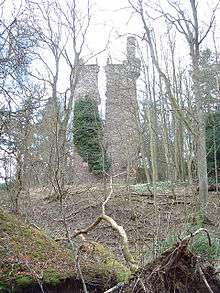Finavon Castle

Finavon Castle lies on the River South Esk, about a quarter of a mile south of Milton of Finavon village and five miles to the north-east of Forfar in Angus, Scotland. The name is applied both to a ruined 17th-century castle, as well as the 19th-century mansion house 130m to the west.
History
The estate was the property of the Lindsay Earls of Crawford from 1375, who built the now-ruined castle. David Lindsay, 10th Earl of Crawford, married Margaret, the daughter of Cardinal David Beaton, at Finavon in 1546.[1]
Extravagance ruined the Crawford fortunes, and in 1625 the barony of Finavon was disposed of by a forced sale to Alexander Lindsay, 2nd Lord Spynie. It passed through the Carnegie family, the Gordon Earls of Aboyne and the Gardynes.
In 1843 the Castle was bought by Thomas Gardyne of Middleton. Through an 18th-century marriage he came of the old Lindsay stock. His descendant, Lieutenant-Colonel Alan David Greenhill Gardyne died in 1953, leaving the estate to a daughter, Mrs Susan Mazur.[2]
The castle

The castle was an L-plan tower-house of five storeys, with a garret and a courtyard. The tower visible today dates from about 1600. Excavations have revealed that the tower is an adjunct tacked onto the north-east corner of a much older, more extensive structure.[2]
The house
The house is a Scottish baronial style mansion built in 1865 for the then laird, David Greenhill Gardyne, by Messrs Carver and Symon of Arbroath.[2] Part of the castle is now let as holiday accommodation.
Life at the Castle
J. B. Burke recorded what life was like at Finavon Castle, saying:
The inner life of the family was of an [sic] uniform but enjoyable character; martial exercise, the chase, and the baronial banquet, enlivened by the songs of the minstrel and the quips of the jester, occupied the day and the evening was wiled away in ‘the playing of the chess, at the tables, in reading of romans, in ringing and piping, in harping, and in other honest solaces of great pleasure and disport,’ the ladies mingling in the scene throughout, whether in the sports and festivities of the morning, or the pastimes of the evening—though a portion of the day was always spent in their ‘bowers’ with their attendant maidens spinning or weaving tapestry. Occasionally, indeed, a higher responsibility devolved upon them,—during the absence of the Earl, whether in attendance on the Parliament or in warfare, public or private, his wife became the chatelaine or keeper of his castle with full authority to rule his vassals, guide his affairs, and defend his stronghold if attacked at disadvantage during his absence.[3]
Other nearby features
The nearby Finavon Doocot is Scotland's largest doocot, with 2400 nesting boxes. It is believed to have been built for the Earl of Crawford in the 16th Century and is now maintained by the National Trust for Scotland.[4]
On Finavon Hill, above the Castle there is a vitrified Iron Age hillfort dating from the mid-1st millennium BCE.[5]
The Finavon Castle beat on the River South Esk provides salmon and seatrout fly fishing.[6]
References
- ↑ Gazeteer for Scotland. "Finavon Castle". Retrieved 2007-04-28.
- 1 2 3 Simpson, W. Douglas (1956). "XV Finavon Castle" (PDF). Proceedings of Society of Antiquaries of Scotland. 89: 398–416. Retrieved 2013-06-17.
- ↑ Burke, J. B., ed. (1850). The St. James's Magazine and Heraldic and Historical Register. London. p. 55. ISBN 978-1144628831. Retrieved 25 Aug 2016.
- ↑ VisitAngus. "Finavon Doocot". Retrieved 2007-04-28.
- ↑ "Department of Archaeology 45th Annual Report". University of Edinburgh. 1999. Retrieved 2012-11-03.
- ↑ "Finavon Castle Fishing". Retrieved 2007-04-28.
- Jervise, Andrew (1882). The Land of the Lindsays. Edinburgh: David Douglas. Rewritten and corrected by James Gammack
- Historic Scotland. "Listed Building Report". Retrieved 2007-04-30.
- National Monuments Record of Scotland. "Site Reference NO45NE 18 (Old Castle of Finavon)". Retrieved 2007-04-30.
Coordinates: 56°41.8485′N 2°49.5735′W / 56.6974750°N 2.8262250°W